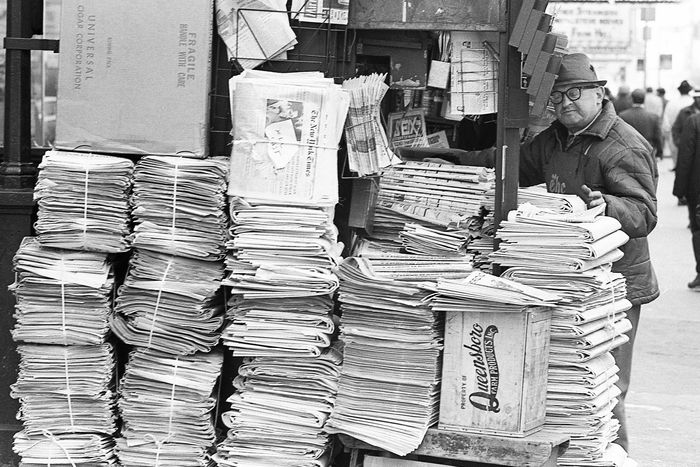
It used to be a mark of Manhattan sophistication that you’d read the Sunday New York Times on Saturday night. Any newsstand or corner deli received copies in the evening, and the Sunday paper, back then, was immense, eight or so pounds of newsprint. News dealers would assemble the sections and pile up the finished papers in a wall along the sidewalk. At the height of their presence in New York, in the 1950s, there were 1,500 independent newsstands in Manhattan, hawking hundreds of dailies, weeklies, and magazines, and there’s endured a belief that even with the demise of too many of those papers to list, we would always be able to buy a copy of the Times in its own city.
Just try to find one in downtown Manhattan these days, though. It’s a lot harder than you’d expect. Most bodegas and delis no longer carry it. Neither does Starbucks. A spokesperson for the New York Times Company acknowledged that the Times’ general decline in print-subscription revenue (2 percent in the fourth quarter of 2021) was “driven by lower single-copy sales,” but declined to share any information about retailer counts beyond the claim that it has “broad distribution across Manhattan for both home delivery and newsstand.”
So we went out to see how dire the newspaper-acquisition situation really is. There are 276 licensed newsstands left in Manhattan, according to the Department of Consumer and Worker Protection, with more than half of those between 14th and 59th Streets. On a recent summer day, though, roughly half of the stands in Gramercy and Chelsea were closed, even on arteries like 23rd. They’re not being replaced, either: There were 66 applications for newsstand licenses in 2019, but fewer than 20 every year since. The dedicated news store (like Casa Magazines on 12th Street and Eighth Avenue, or Newspapers on 23rd, which stocks Chinese-, Spanish-, and Greek-language newspapers as well as the Jewish Press and the Irish Voice) is nearly extinct.
Even finding an open newsstand is no longer a guarantee of snagging the paper. According to the DCWP, a licensed newsstand “must sell newspapers, magazines, or periodicals,” but selling the news has, for many, become untenable. Newsstands make money on gum, candy, and phone accessories, not papers, and they can’t sell anything big. In 2019, The New Yorker quoted a lawyer who represents the New York City Newsstand Operators Association saying that “newsstand operators … feel lucky if they sell 50 newspapers a day.” After living through the pandemic, multiple operators told me they’re lucky to sell 15. Many have stopped trying to sell papers entirely. The only newsstands that are obviously still selling a lot of copies are the big ones in Penn Station and Grand Central Terminal.
Of the 16 newsstands I surveyed between 14th and 34th Streets in a recent week, several were closed and a grand total of two had papers for sale. One operator, who says he’s been working at newsstands since 1987, says digital news put his stand on the ropes, but coronavirus dealt the killing blow. He closed down for 18 months during the pandemic, and when he managed to reopen, “No customers, in the six months I opened. Nobody buys.” After a month or two, he stopped getting papers delivered. A few blocks away, another newsstand worker said his stand was still getting the Times for now, but if business didn’t pick up by the end of the month, his boss was thinking of canceling their order. As for delis and bodegas, the Times appeared three times out of 20. A working, not entirely scientific theory: The more likely a deli is to have “Marketplace” or “Gourmet” in its name, the less likely it is to sell the paper, and if it sells any kind of CBD product, you’re entirely out of luck.
Bookstores, too, are hit-or-miss: Barnes & Noble gets the paper every day, but the Strand and even McNally Jackson never did. A number of 7-Elevens carry the paper. When they arrived in Manhattan in 2005, they were hailed by NPR as an existential threat to bodegas, and, in effect, to the New York way of life, but now they’re doing some of the heavy lifting to keep print papers on the city streets.
A few news dealers are holding on. It’s hard to have better foot-traffic real estate than 14th and University Place, and the man behind the counter there, who asked to be quoted only as “the newsstand guy,” still gets a bundle of papers every day. “I used to stand in the cold selling the New York Times — that’s how I started,” he recalled. “We’d sell 60, 70 copies of the early edition, 200, 300 copies of the late, at a slow location. In the terminal, a thousand copies a day.” On a recent summer Tuesday, despite the crush of street traffic, tourists in the streets, people lazing in the park, he’d sold a total of six. He sells out only if there’s big breaking news, he says, or on Wednesdays for the food section, which is another way of saying that people tend to use hard copies of the Times these days the same way they use Twitter and Yelp: for headlines and reviews, and maybe for recipes. “You want the future?” the newsstand guy said. “Don’t go to newsstands.” Some are no longer even selling the record of the present.
The Link LonkJuly 27, 2022 at 03:49AM
https://www.curbed.com/2022/07/why-is-it-so-hard-to-buy-a-copy-of-the-new-york-times.html
Why Is It So Hard to Buy a Copy of the Times? - Curbed
https://news.google.com/search?q=hard&hl=en-US&gl=US&ceid=US:en
No comments:
Post a Comment